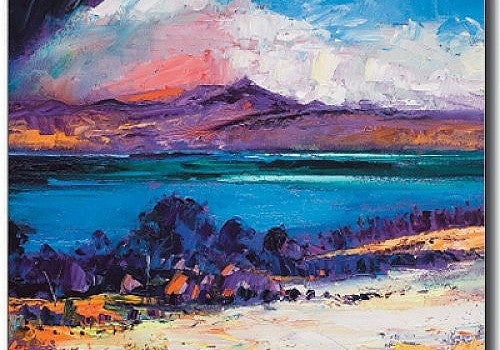
Article Detail
04 May

In Jolomo, a love of art was fostered at a young age by his family and most notably by his mother’s father, Henry, who was an accomplished water-colourist. His country, too, pushed him toward his craft. The history of Scottish art boasts a rich roster of landscape artists – perhaps unsurprising, when one considers that the nation boasts such a plethora of suitable scenery to paint.
His passion brought him to the Glasgow School of Art in 1967, where his career would develop in stark contrast to those around him. While his peers were obsessed with the bold pop-art style popularised by Andy Warhol, Jolomo was more taken with the expressionism of Kokoschka. While his contemporaries wrote their dissertations on art history, he wrote his on art therapy.
During his time at art school, Jolomo also developed an interest in more abstract design. He would enter in a fashion design competition run by Copeland & Lye, Glasgow’s premier fashion designer, and claim first prize. His real passion, however, was for landscape and when he was forced to make a choice between design and painting, it was the latter which won out.

After he left art school, his career did not go altogether smoothly. It would take another four years before his first solo show and like many artists, Jolomo had difficulty making his craft financially viable. As by this time he had a young son to support, he realised that he had to make another choice: between his dream of becoming an artist and the reality of making ends meet.
He trained as a teacher and began to teach art at Lochgilphead, a small town in Argyll. During this time arrived another two sons and so his teaching career was extended further. Though he told himself that this position would last ten years, he ended up spending twenty-five years teaching before finally returning to his craft full-time.
While it was borne from necessity rather than passion, in the end, the time spent teaching wasn’t quite such a huge sacrifice. Jolomo quickly realised that he enjoyed the work and quickly secured a promotion to head of art before being made art adviser for the entire region.
He explained his phenomenal output in an interview with The Scotsman. “I’ve got several dozen metal drawers full of several thousand works, mainly landscape work I did when I was teaching. That’s me. I’ve got to paint. There’s no other reason for getting up in the morning for me, apart from to get into the studio and paint.”
While his upbringing was religious, it wasn’t until his time at art school that his faith began to influence his work. This influence is most obvious in a series of paintings from 2002, which depict several scenes from scripture, including the crucifixion, the resurrection of Lazarus, and Judas’s betrayal of Jesus with a kiss.
Whilst his faith is rarely so overtly expressed in his work, it often finds its way in through more subtle means. Jolomo’s landscapes are comprised, in the main, of quite a unique and striking palette of colours, many of which are undoubtedly drawn from religious symbolism.
Historically, certain colours have come to represent certain aspects of the Christian faith. For example, blue is associated with purity, such as that of the Virgin Mary (which is why she is always depicted in blue. It is, after all, highly unlikely that a poor Nazarene woman would have been able to acquire dyed clothes). Red, on the other hand, is associated with glory and sacrifice and so it has come to represent God and Jesus. Greens and Yellows came to be associated with evil and treachery, and so were often avoided in the same way that the diminished fifth was proscribed in music.

Many of the colour schemes in Jolomo’s work are heavily influenced by these early schools of religious thought. His landscapes will feature calming blues – particularly in the sky. One might obviously attribute this to the fact that the sky is blue, were it not for the fact that much of Scotland is covered in green grass, a colour largely absent from the vast bulk of Jolomo’s portfolio (to say nothing of the fact that the sky in Scotland is, more often than not, grey.)
Moreover, Jolomo’s paintings often feature a single ‘key’ colour, offset by darkness. This effect is known in art circles by its Italian term, chiaroscuro. This, too, holds religious significance and is often used to denote an ongoing struggle between two opposed forces: yin and yang; light and darkness; good and evil; God and Satan. In his later years, he would come to embark on a study of theology, which would ultimately lead to him being appointed a reader at the Church of Scotland.
Jolomo’s avoidance of the colour green can be explained by the fact that the colour is too easy and that the artist has had difficulty achieving the precise shade of green that he had envisaged. He has only recently developed a shade which he is satisfied with. Curiously, the absence of such an obvious colour has lent Jolomo’s landscapes a surreal quality which underpins much of their appeal.
Though Jolomo’s landscapes rarely feature people (he feels that they often distract from the true subject of the work) they often indicate man’s impact on the world. His work will frequently feature pieces of broken flotsam and jetsam in the foreground – features which, he has claimed, will feature more prominently in his future work.
His work has never found much traction among critics, who are largely quick to seize upon his prodigious output as a weakness of character and dismiss him as a one-man production line. This criticism, as one might imagine, is not something which Jolomo pays much heed to – he is far too busy enjoying himself.
While Jolomo’s work is widely appreciated, the same cannot be said of many other landscape artists. The artform, thought Jolomo, was dying. While some might have made this observation with a degree of relish, Jolomo thought that something should be done about it. And so, in 2007, he established the Jolomo Lloyds TSB Scotland prize for new or emerging landscape painters.
The top prize of £25,000 is on a par with the Turner prize, and it is hoped that this will help to give more traditional forms of art room to breathe in a media landscape dominated by sensationalist contemporary artists like Damian Hirst. This prize has since been awarded to a variety of would-be Jolomos and helped to revive a dying artform. As for Jolomo himself, he continues to devote as much of his free time to art as he has done for the past fifty years – and his output shows little sign of diminishing.
Scotland owes thanks to a talented one of a kind who continues to inspire generations and produce art packed with creativity and imagination. His legacy is one that we are proud to be connected to as a local business selling some of his exceptional merchandise that capture his works, brightening up homes everywhere.
 Free delivery on orders over £20
Free delivery on orders over £20






